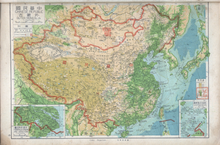Pinyin postal

Au début du XXe siècle, la Chine (à la fin de la dynastie Qing) utilisait le système de pinyin postal (chinois : 郵政式拼音 ; pinyin : ), basé sur le Wade-Giles dans un but postal, principalement pour les toponymes sur les lettres et les timbres ; il n'était pas d'un usage universel. Il emploie certains noms européens de lieux chinois déjà communs qui remplacent le système Wade-Giles et inclut quelques prononciations des langues locales.
Le système postal fut décidé après la Conférence mixte des Postes impériales (帝國郵電聯席會議) du printemps 1906 à Shanghai.
Les principales différences avec le Wade-Giles sont les suivantes :
- l'absence complète de diacritiques servant à noter les tons ;
- Chi, ch'i et hsi (ji, qi et xi en hanyu pinyin) sont respectivement représentés soit par tsi, tsi et si, soit par ki, ki et hi selon la prononciation historique, par exemple :
| Wade-Giles | Hanyu pinyin | |
| Peking | Pei-ching | Běijīng |
|---|---|---|
| Tientsin | T'ien-chin | Tiānjīn |
| Tsinan | Chi-nan | Jǐnán |
- à moins qu'il soit la seule voyelle de la syllabe, le u du Wade-Giles devient w :
| Wade-Giles | Hanyu pinyin | |
| Ankwo | An-kuo | Ānguó |
|---|---|---|
| Chinchow | Chin-chou | Jǐnzhōu |
- les noms de lieux du Guangdong, du Guangxi et du Fujian sont romanisés selon les langues locales, comme le hakka, le cantonais, le min :
| Wade-Giles | Hanyu pinyin | |
| Amoy | Hsia-men | Xiàmén |
|---|---|---|
| Swatow | Shan-t'ou | Shàntóu |
| Quemoy | Chin-men | Jīnmén |
- les toponymes européens populaires préexistants (XIXe siècle ou avant) sont retenus ; par exemple :
| Wade-Giles | Hanyu pinyin | |
| Canton | Kuang-chou | Guǎngzhōu |
|---|
Articles connexes
[modifier | modifier le code]Text is available under the CC BY-SA 4.0 license; additional terms may apply.
Images, videos and audio are available under their respective licenses.
